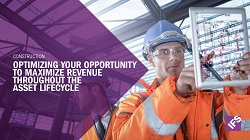By taking on service and asset management, construction and contracting companies can generate revenue across the total asset lifecycle.
In this Q&A, Kenny Ingram, construction and contracting industry expert and Global Industry Director at IFS, answers questions on how companies can generate revenue by taking on service and asset management.
 Kenny has been with IFS for more than 16 years and has worked in the business systems marketplace for over 20 years. He is now regarded as one of the top specialists in project-based business systems and has been heavily involved in driving the IFS strategy in this area for the last 16 years. Prior to this, Kenny held various positions covering management and project accounting, supply chain and logistics.
Kenny has been with IFS for more than 16 years and has worked in the business systems marketplace for over 20 years. He is now regarded as one of the top specialists in project-based business systems and has been heavily involved in driving the IFS strategy in this area for the last 16 years. Prior to this, Kenny held various positions covering management and project accounting, supply chain and logistics.
Question 1
Why are many construction and contracting companies wanting to take on service and asset management?
Answer: There are many reasons why construction companies are becoming increasingly attracted to service management and asset management.
Firstly, most companies are looking to grow and improve their margins. There are a limited number of construction projects that a company can bid for at any time, so the opportunity to grow is limited. In contrast, every existing asset needs to be maintained so that there are more revenue opportunities in asset and service management than there is in new-build construction.
There is another opportunity, which is first to bid for the service contract when bidding for a new asset build project, and secondly, to bid for the service renewal contracts on existing assets. So, there is a big opportunity for growth here.
The second reason is to reduce risk and make the company more future proof. Construction companies who only do new-build or major refurbishment contracts suffer from the lumpy and unpredictable nature of doing business in this way. Revenue and profit are typically very lump. If you win one big contract it can make your financial numbers great but of course, if you lose a contract, the opposite can apply.
Service and facilities management contracts are typically awarded on a medium- to long-term basis, typically 5 to 10 years and the revenue tends to be evenly spread across the duration of the contract. This means that it is much easier to forecast this revenue stream.
So, if a business has 70% of its revenue coming from servicing and operating assets and 30% of its revenue from new build construction projects, then the total revenue and profit will be much more predictable and smoothed. This reduces the risk that they could see a big fall in their financial performance, particularly when a recession hits and new-build contracts dry up.
In short, it makes their business more future proof. The owners and directors of these companies are of course concerned about the share price and market value of their company; therefore, the above diversification is very likely to have a positive impact on the share price and value the business. Banks and investors will also find this more attractive.
Finally, all of the above will usually make the company more attractive to potential clients. Clients want to know they are dealing with a financially stable company and are increasingly looking for the construction company to offer a total asset lifecycle service.
Question 2
What’s driving this change?
Answer: There are a number of trends driving this change. As we discussed earlier, the construction companies want to make their businesses more financially stable and attractive.
Perhaps of even greater importance is that clients and asset owners are increasingly focusing on a total asset lifecycle view. They are looking at the total cost of the assets life. If you look at most assets, the construction cost is usually <20% of the total asset lifecycle cost. Traditionally, the construction company bids to build the asset and has little or no incentive to worry about how easy or how costly it will be for someone to operate and maintain the asset once it is handed over.
There are many examples where assets are designed without any regard to how difficult it will be to maintain them.
The asset owners are now focusing on TOTEX (CAPEX + OPEX). The focus is now to design assets that are easy to manufacture, construct, operate and maintain. For example, you would not design an aircraft that was difficult, slow and expensive to maintain, so why should a building or infrastructure asset be any different?
Digital technology trends and process initiatives like Building Information Modeling (BIM) and the Internet of Things (IoT) are also accelerating this trend.
In addition, the owners are increasingly focusing on the performance and uptime of the asset. After all, if an asset cannot be used, it cannot deliver what it is designed to deliver. Thus, the concept of outcome-based contracts is certainly a trend that is likely to transform the industry.
So, if an asset owner wants the best result why would they not place a contract with one company to design, construct, maintain and operate the asset and ultimately make that organization contract for the outcome of the asset? This is the big change that is coming, so construction companies are going to be forced to change the way they deliver solutions.
Question 3
Why are contracts expected to become more complex?
Answer: Outcome- or performance-based contracts are nothing new. Think of the aviation industry where power-by-the-hour contracts have been around for many years. In this concept, an aircraft engine supplier may contract based on the number of flying hours so the airline is not paying when the engine is not flying. So perhaps a construction company may bill for a hospital based on how many beds are filled or maybe even based on how quickly patients return to health or maybe a construction company who builds a school pays based on exam results.
If these types of contracts were put in place, then imagine the massive change this would enforce on how a construction company works and the type of information and processes they would need to have to ensure that their contracts are profitable.
Question 4
How can enterprise software help and what should companies look for when selecting a solution?
Answer: When you consider the magnitude of the above change that is about to hit the construction industry, then it is clear that most construction company’s business systems are not capable of satisfying these new demands. Some may think they can muddle through using lots of MS Excel spreadsheets like they do today. This is unlikely to cut it in the future.
In addition, there is also a big trend towards offsite modular manufacturing in the industry. This is likely to accelerate the pace of new entrants to the industry – perhaps companies like Amazon may enter the industry who would arrive with a much more disciplined process driven approach.
What does this mean? In the future, your business systems will have to be more integrated and allow construction projects to be managed in a more professional way. The importance of design will intensify, and integrating BIM design data will become mandatory. The assets, as built structures, will need to be transferred automatically to the enterprise asset management (EAM) solution. This, of course, means that these companies will need to have software that can support construction project execution and asset management.
The asset management solution will have to be integrated with the IoT and other digital technologies to perform analytics on how the asset is performing and to drive predictive maintenance.
You will need tools that allow your mobile workforce to execute work on mobile devices and tools to optimize them.
The contract management solution will have to be very flexible to adapt and deliver complex performance- and outcome-based contracts.
The need to be able to measure every aspect of the assets life will be demanded by the client and the construction company will need the ability to analyze contract costs and revenue to make sure they can deliver these projects profitably.
In addition, if you need to build and manage a modular offsite facility, you will need a solution that can run a lean manufacturing plant and manage complex shipping and logistics processes to deliver to site at the right time.
In short, you will need software to allow you to become a complete asset lifecycle solution provider.
 Want more on this topic?
Want more on this topic?
For more expert-to-expert advice and insight, download the Construction: Optimizing your opportunity to maximize revenue throughout the asset lifecycle eBook.
Do you have questions or comments about how to generate revenue via service management and/or asset management?
We’d love to hear them so please leave us a message below.
hochtiefindia
Nice Post, your blog is very informative.Thanks for sharing.
Rusbe
Great post on Asset Life cycle Management….Is this applicable for BIM as well?